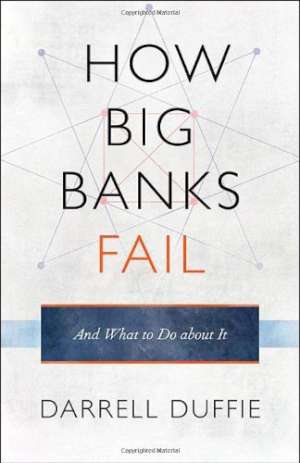15 June 2011
How Big Banks Fail – And What to Do About It
Darrell Duffie
2010, Princeton University Press, 115 pages, £20.95
ISBN 9780691148854
Reviewer: Saxon Brettell, Head of Research, City of London

Bagehot’s 1873 Lombard Street stresses the lender of final resort role of the central bank during the “periodical seasons of delicacy” that are recurring banking crises. Lending freely at such times to “illiquid but solvent” banks and basing such lending on collateral valued at “pre-crisis” levels will restore trust and prevent failure of the whole system of finance and the collapse of trade and investment. As Darrell Duffie explains in How Big Banks Fail, for modern central banks facing the prospect of collapse in one or more of the global ‘Dealer Banks’ at the heart of the modern financial system, this problem is more complex to solve.
Duffie explains the mechanics and incentives generating failure in ‘Dealer Banks’ – the 20 or so major global dealers that dominate the intermediation of over-the-counter (OTC) securities, covering corporate and municipal bonds, sovereign debt, and securitised credit products. In globalised financial markets, the complex collateralised assets they deal in are financed through inter-bank funds, negotiable certificates of deposit (CDs) and repurchase agreements (repos). Fundamental asset valuation is thus complicated by an exposure hedged and insured through interest, currency and default swaps that are themselves used as instrument of speculation.
The book presents a measured exposition of the way in which a loss of trust can progressively work through to accelerate the failure of a Dealer Bank. The book looks at the Bear Sterns and Lehman Brothers collapses in 2008 and seeks to make some general but illuminating points about process. This is a clear and readable account of the mechanisms and incentives at play.
The primary task in the title is addressed in Chapter 3, which reviews ‘failure mechanisms’. A run on a Dealer Bank is shown to work its way through OTC derivatives, rep, prime brokerage and clearing. The crucial role played by a downgrading of a credit rating as a trigger for more contagion and rapid loss of cash is a phenomenon that would be less familiar to Bagehot, but he would recognise the description of the dual incentives for dealers to signal strength through continued trading while counterparties exit positions as fear of default grows.
Chapter 4 touches on the secondary task looking at solutions for dealing with the debt overhang, for example automatic recapitalisation by converting debt to equity is triggered in contingent capital. CoCos are an interesting example of a two pronged solution as they increase capital after the event but give moral hazard benefits by incentives to ensure a bank’s strategies have long-term sustainability – an attractive solution to the bonus/remuneration issue if given to traders. Chapter 5 reviews regulatory and supervisory infrastructure solutions and includes an exposition of the potential role for central clearing for OTC derivatives and of introducing ‘living wills’ to increase the ability of these big banks to fail without systemic implications. This is the chapter that has the shortest shelf life in what is overall a really useful book.
